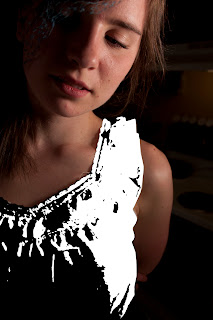The book Constructed Realities: The Art of Staged Photography, edited by Michael Kohler, describes the affect of viewers haven't a shorter attention span, “We therefore consume images fleetingly and randomly. It takes very special pictures to grasp and hold our attention. We need to be seduced by images that outdo reality through excessiveness—as in advertising and movies.”
A lot of people think all these "changes" that are occurring in the world today, like colloquial language including things like "lol", and people feeling the need to check facebook every couple of hours. True, these things are new and different, and people are changing, but why is that a bad thing? Things are always changing. Things have always changed and they always will. As easily as you could argue that we're all changing, you could argue we're still the same. I think it's in human nature to prefer talking to people in person, and although many people do spend a lot of their time on social network sites, usually those relationships started face to face or, as in the case with tweet-ups, where people who follow each other on twitter can meet in person. I think people's attention span is changing, but so what? The idea of art has always evolved and changed, and the fact that our attention spans are getting shorter could produce a challenge to creating artwork that artists really enjoy. But even as I say this, I do try to have patience with not only images, but just things in general. I prefer slower takes in movies, long shots in scenes, and slower reads in artwork. But in advertising, I do want something that will capture my attention fast because I don't have time to care. Generally, it's good design that captures my attention first, which means designers have a challenge in the advertising industry. But it's a fun challenge, and I don't think we should be upset about it.
Another excerpt from the same book explain the term "infotainment" and how contemporary people react to them,
“But the term ‘Infotainment’ also implies this: with the gradual fictionalization of even the news, the old categorical oppositions of ‘documenting’ and ‘staging’, appearance and reality gradually dissolve. They are being replaced by a variety of hybrid forms for which it will be impossible, in fact pointless, to attempt to distinguish between fact and fiction. Even the accusation that ‘Infotainment’ is guilty of continuous ‘lying’ is therefore unjustified, for it is neither ‘true’ nor ‘false’. Like advertising, movies and all other genres that adhere to the laws of fiction, it works at a level beyond these oppositions—the level of ‘hyper-reality’, where reality is ‘simulated’.”
I think sensible people understand that infotainment is not reality. Of course there are some people who can't tell the difference, such as little kids who think Dan Radcliffe can actually do magic. I do believe that people often wish the "reality" they see in magazines and commercials is an "ideal" reality from which a lot of people develop a desire for. But that is not a new thing. In photography there is that aspect of "Is it real or isn't it" because things can easily be manipulated. I think these images can create something that is magical and we might think it's real, but same with the French trapeze artist, Lola, from the 19th century, who could hold herself up with her teeth. Apparently she was held up by a frame or wires. It's the same concept. People were deceived. Even if the audience knew it couldn't happen, for the sake of entertainment, they extended their belief beyond things that made sense. In Photography people do the same thing. Even if we know magic isn't real, it's fun to see a magic trick, but the trick isn't as fun once we know how it works (sometimes, anyway).


















